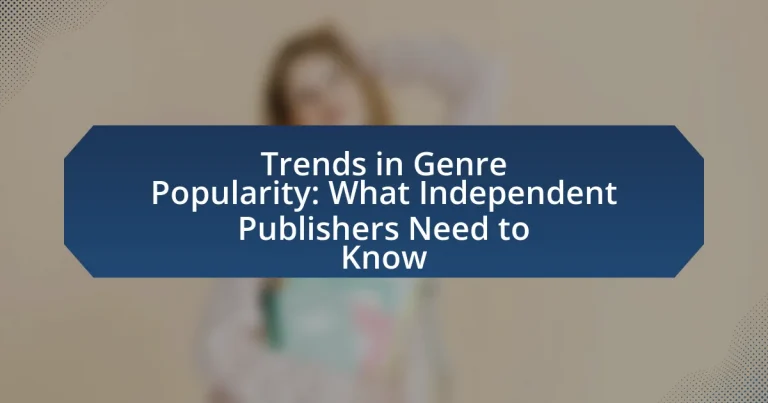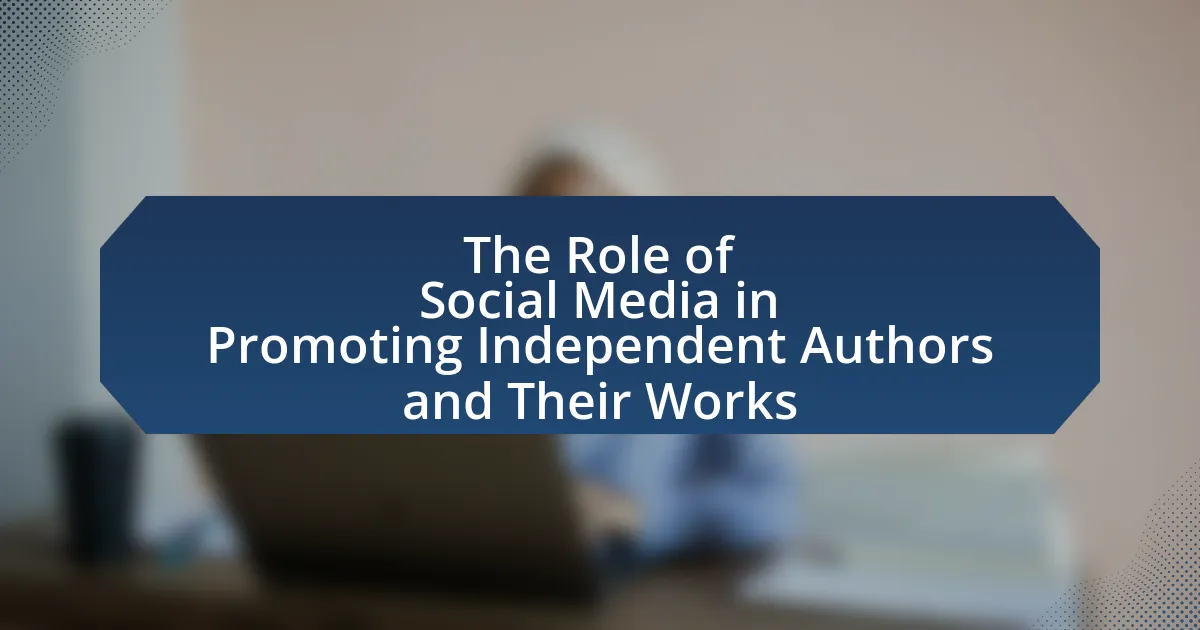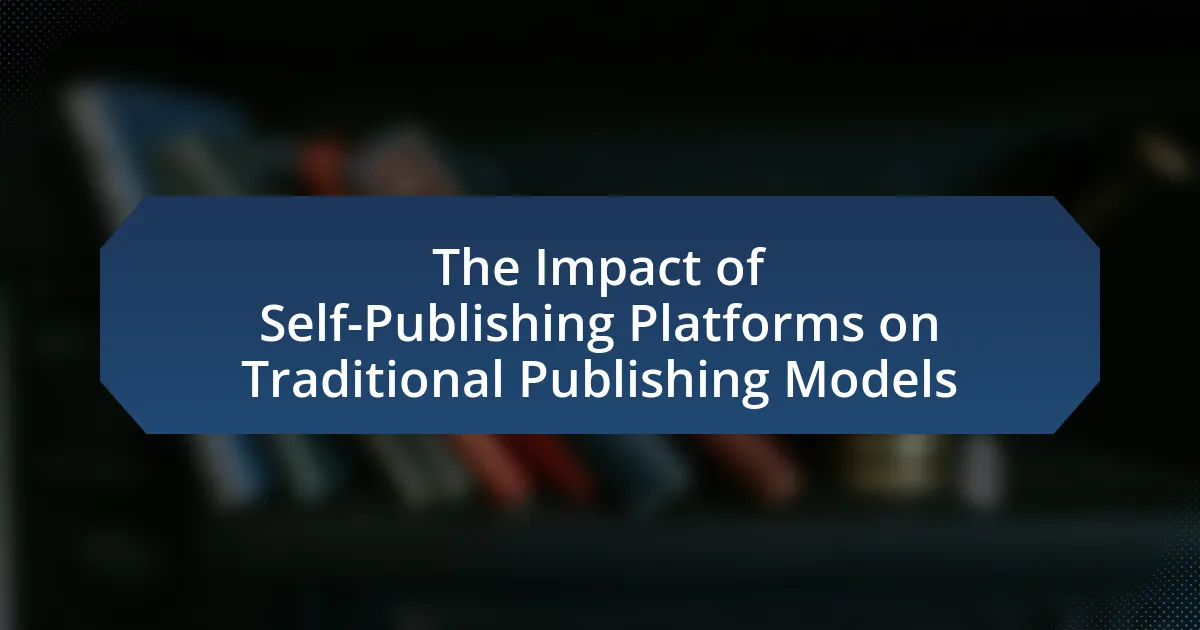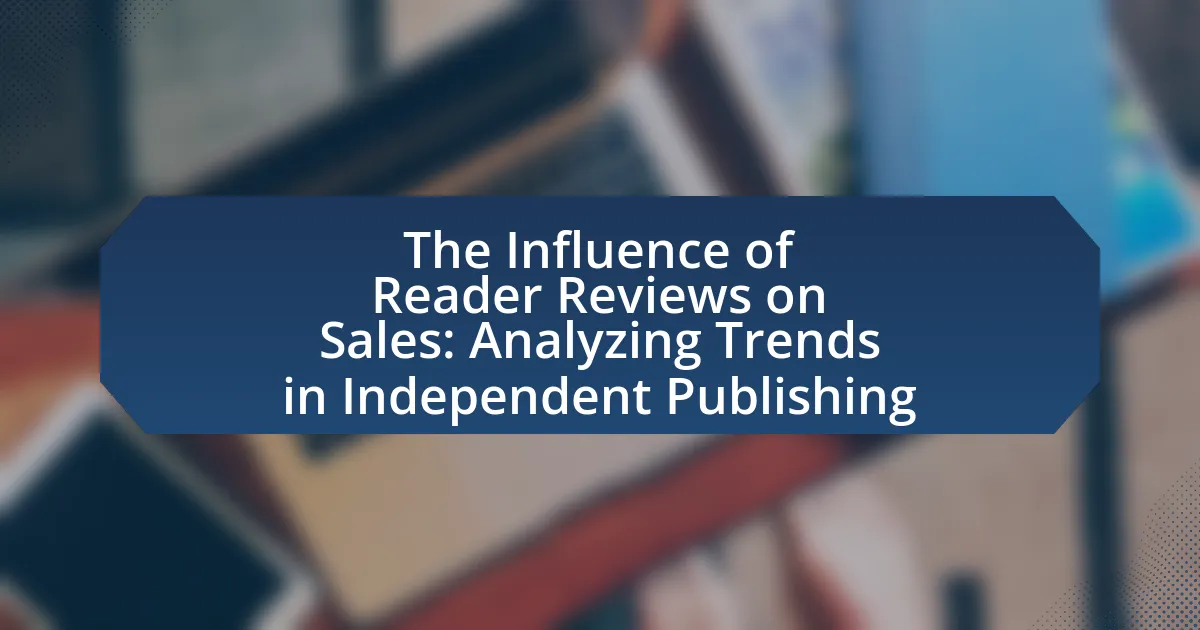The article focuses on current trends in genre popularity relevant to independent publishers, highlighting the significant rise in demand for romance, fantasy, and thriller genres. It examines how these trends impact the publishing landscape, influencing market demand and shaping publishing strategies. Key factors contributing to shifts in genre popularity include cultural trends, technological advancements, and changing consumer behavior. The article also discusses the importance of understanding reader preferences, the challenges independent publishers face in navigating these trends, and practical strategies for adapting to the evolving market. Additionally, it emphasizes the role of market research and community engagement in enhancing genre awareness and selection.
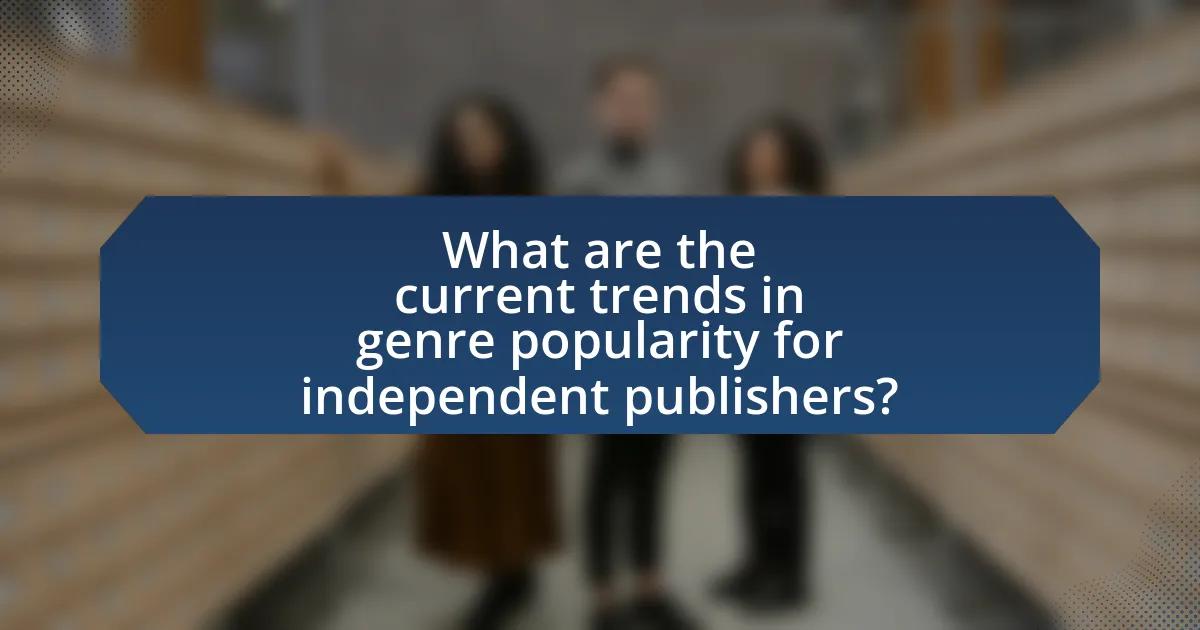
What are the current trends in genre popularity for independent publishers?
Current trends in genre popularity for independent publishers indicate a significant rise in demand for genres such as romance, fantasy, and thriller. According to a 2023 report by the Independent Book Publishers Association, romance has consistently topped sales charts, accounting for over 30% of independent book sales, while fantasy and thriller genres have seen a surge in readership, particularly among younger demographics. This shift reflects changing consumer preferences, with readers increasingly gravitating towards escapism and emotional engagement found in these genres.
How do genre trends impact the publishing landscape?
Genre trends significantly impact the publishing landscape by influencing market demand and shaping publishing strategies. For instance, the rise of genres like fantasy and romance has led to increased investment in these categories, resulting in more titles being published and greater marketing resources allocated. According to the Association of American Publishers, in 2020, the romance genre alone generated over $1.4 billion in sales, demonstrating its substantial influence on the market. Additionally, shifts in reader preferences towards genres such as thrillers and non-fiction have prompted publishers to adapt their catalogs and promotional efforts to align with these trends, ultimately affecting the types of books that are produced and the success of independent publishers in a competitive environment.
What factors contribute to shifts in genre popularity?
Shifts in genre popularity are primarily influenced by cultural trends, technological advancements, and consumer behavior. Cultural trends, such as societal issues or movements, can lead to increased interest in specific genres that resonate with current events, like the rise of dystopian fiction during times of political unrest. Technological advancements, particularly in digital media and streaming platforms, enable easier access to diverse genres, allowing niche genres to gain traction. Consumer behavior, including changing demographics and preferences, also plays a crucial role; for instance, younger audiences may gravitate towards genres like young adult fiction or graphic novels, impacting overall popularity. These factors collectively shape the landscape of genre popularity over time.
How do reader preferences influence genre trends?
Reader preferences significantly influence genre trends by dictating which genres gain popularity and commercial viability. As readers express their interests through purchasing behavior, social media engagement, and online reviews, publishers and authors adapt their offerings to align with these preferences. For instance, the rise of young adult fiction in the 2010s can be attributed to a growing demand for relatable themes among younger audiences, leading to an increase in titles within that genre. Additionally, data from the Association of American Publishers indicates that genres like romance and fantasy have seen substantial growth due to reader engagement metrics, such as increased sales and online discussions. This responsiveness to reader preferences shapes the publishing landscape, guiding independent publishers in their strategic decisions regarding which genres to focus on.
What genres are currently gaining traction among readers?
Currently, genres such as psychological thrillers, fantasy, and romance are gaining traction among readers. Psychological thrillers have seen a surge in popularity due to their gripping narratives and complex characters, appealing to readers’ desire for suspense and intrigue. Fantasy continues to captivate audiences, particularly with the rise of diverse voices and innovative world-building, as evidenced by the success of series like “A Court of Thorns and Roses” by Sarah J. Maas. Romance remains a strong genre, bolstered by the popularity of contemporary and diverse love stories, which have led to increased sales and readership, as reported by the Romance Writers of America.
Which genres have seen the most significant growth recently?
The genres that have seen the most significant growth recently are romance, particularly sub-genres like contemporary and romantic suspense, as well as fantasy and science fiction. According to a report by NPD Group, romance book sales increased by 50% from 2020 to 2021, while fantasy and science fiction also experienced a notable rise, with sales growing by 30% during the same period. This surge in popularity can be attributed to changing consumer preferences and the increased availability of diverse voices within these genres.
What emerging genres should independent publishers consider?
Independent publishers should consider genres such as climate fiction, speculative fiction, and diverse narratives. Climate fiction, or “cli-fi,” addresses environmental issues and has gained traction as readers become more aware of climate change, with notable works like “The Overstory” by Richard Powers highlighting its relevance. Speculative fiction explores futuristic or alternative realities, appealing to audiences seeking imaginative storytelling, as seen in the popularity of series like “The Handmaid’s Tale” by Margaret Atwood. Additionally, diverse narratives that reflect varied cultural experiences are increasingly sought after, as evidenced by the success of books like “The Vanishing Half” by Brit Bennett, which resonate with readers looking for representation. These genres not only reflect current societal interests but also offer independent publishers opportunities to engage with evolving reader preferences.
Why is it important for independent publishers to stay informed about genre trends?
It is important for independent publishers to stay informed about genre trends because this knowledge directly influences their publishing decisions and market competitiveness. Understanding current genre trends allows independent publishers to identify popular themes, styles, and reader preferences, which can lead to better-targeted marketing strategies and increased sales. For instance, data from the Association of American Publishers indicates that genres like romance and thriller consistently dominate sales charts, highlighting the necessity for publishers to align their offerings with consumer interests. By staying updated on these trends, independent publishers can effectively position their titles in a crowded marketplace, ensuring they meet the evolving demands of readers.
How can understanding genre trends improve marketing strategies?
Understanding genre trends can significantly enhance marketing strategies by allowing publishers to tailor their promotional efforts to align with current consumer preferences. By analyzing data on genre popularity, such as sales figures and reader engagement metrics, publishers can identify which genres are experiencing growth and adjust their marketing campaigns accordingly. For instance, a report from the Association of American Publishers indicated that sales in the romance genre increased by 20% in 2021, suggesting a lucrative opportunity for targeted marketing in that area. This data-driven approach enables publishers to allocate resources more effectively, create genre-specific content, and engage with audiences through relevant channels, ultimately leading to increased sales and brand loyalty.
What role does genre awareness play in selecting manuscripts?
Genre awareness is crucial in selecting manuscripts as it helps publishers identify market trends and reader preferences. Understanding genre conventions allows publishers to evaluate whether a manuscript aligns with current demands, ensuring that they invest in works that are more likely to succeed commercially. For instance, data from the Association of American Publishers indicates that specific genres, such as romance and thriller, consistently outperform others in sales, highlighting the importance of genre awareness in making informed selection decisions.

How can independent publishers adapt to changing genre trends?
Independent publishers can adapt to changing genre trends by actively monitoring market data and reader preferences to identify emerging genres. Utilizing tools like sales analytics and social media insights allows publishers to track shifts in consumer interests, enabling them to pivot their publishing strategies accordingly. For instance, the rise of genres such as psychological thrillers and diverse narratives has been documented in industry reports, indicating a growing demand for these categories. By aligning their acquisitions and marketing efforts with these trends, independent publishers can better meet reader expectations and enhance their market presence.
What strategies can publishers implement to align with popular genres?
Publishers can implement targeted marketing strategies, data analysis, and genre-specific content development to align with popular genres. By analyzing sales data and reader preferences, publishers can identify trending genres and tailor their offerings accordingly. For instance, a report from NPD Group indicates that genres like romance and thriller have consistently high sales, suggesting that publishers should focus on acquiring titles within these categories. Additionally, engaging with readers through social media and online platforms allows publishers to gather insights on emerging trends, enabling them to adapt their catalogs to meet market demands effectively.
How can market research inform genre selection?
Market research can inform genre selection by providing data on consumer preferences and trends within the publishing industry. By analyzing sales figures, reader demographics, and genre popularity over time, independent publishers can identify which genres are currently in demand. For instance, a report from the Association of American Publishers indicated that in 2022, sales of romance novels increased by 20%, highlighting a growing consumer interest in that genre. This data enables publishers to align their offerings with market demand, increasing the likelihood of commercial success.
What are effective ways to promote books in trending genres?
Effective ways to promote books in trending genres include leveraging social media platforms, engaging with book influencers, and utilizing targeted advertising. Social media platforms like Instagram and TikTok have become essential for reaching audiences, as they allow for visually appealing content and direct interaction with potential readers. Engaging with book influencers can amplify visibility; for instance, collaborations with popular bookstagrammers or booktubers can lead to increased interest and sales. Targeted advertising on platforms such as Facebook and Amazon enables publishers to reach specific demographics interested in trending genres, enhancing the likelihood of conversion. According to a 2022 survey by the Book Industry Study Group, 60% of readers discover new books through social media, highlighting the effectiveness of these promotional strategies.
How can independent publishers leverage social media to track genre trends?
Independent publishers can leverage social media by utilizing analytics tools to monitor engagement metrics and trending topics within specific genres. By analyzing data from platforms like Twitter, Instagram, and Facebook, publishers can identify which genres are gaining traction based on user interactions, hashtags, and discussions. For instance, a report from Sprout Social indicates that 70% of consumers feel more connected to brands that engage with them on social media, highlighting the importance of active monitoring. Additionally, tools like Google Trends can complement social media insights by providing search volume data for genre-related keywords, allowing publishers to make informed decisions about their offerings based on real-time consumer interest.
What platforms are most effective for genre trend analysis?
The most effective platforms for genre trend analysis include Goodreads, Amazon, and Google Trends. Goodreads provides user-generated data on book ratings and reviews, allowing for insights into genre popularity and reader preferences. Amazon’s sales rankings and customer reviews offer a direct measure of market demand across various genres. Google Trends analyzes search data to reveal shifts in public interest over time, making it a valuable tool for identifying emerging genres. These platforms collectively provide comprehensive data that can inform independent publishers about current and future genre trends.
How can engagement with readers enhance understanding of genre preferences?
Engagement with readers enhances understanding of genre preferences by providing direct feedback and insights into their interests and reading habits. When publishers interact with readers through surveys, social media, or book clubs, they gather valuable data on which genres resonate most, allowing them to tailor their offerings accordingly. For instance, a study by the Pew Research Center found that 72% of readers prefer to engage with authors and publishers through social media, indicating that such platforms can effectively reveal genre trends and preferences. This engagement not only helps in identifying popular genres but also fosters a community that can influence future publishing decisions.
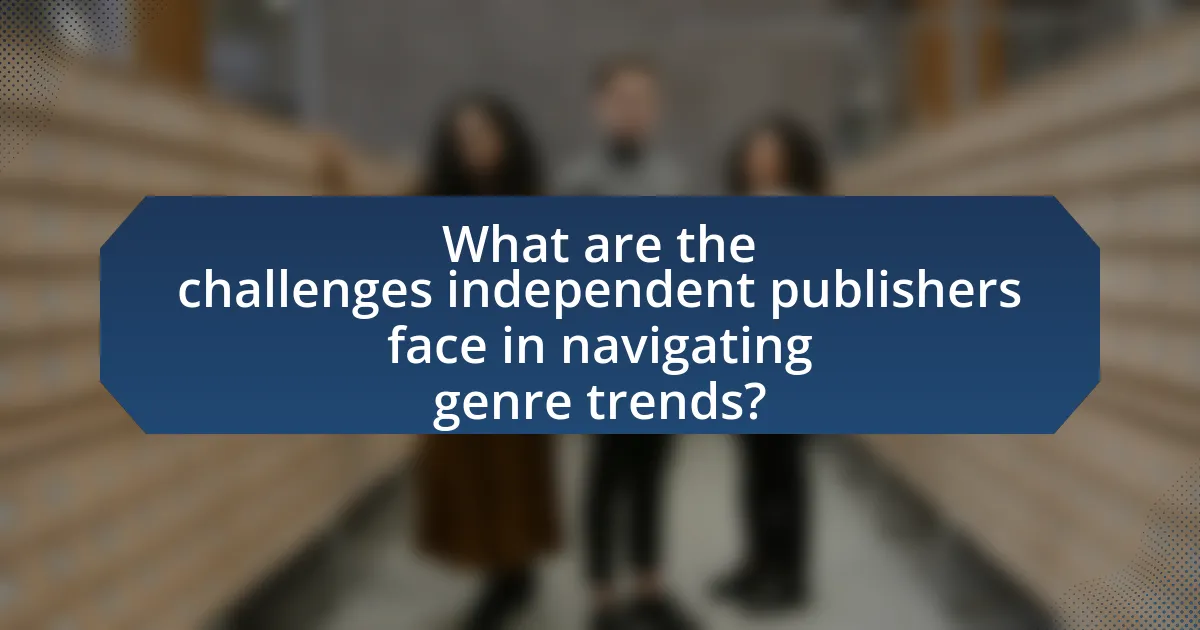
What are the challenges independent publishers face in navigating genre trends?
Independent publishers face significant challenges in navigating genre trends, primarily due to limited resources and market visibility. These publishers often lack the financial backing and marketing reach of larger publishing houses, making it difficult to effectively analyze and respond to shifting reader preferences. For instance, a 2021 report by the Association of American Publishers indicated that independent publishers accounted for only 10% of the overall market share, highlighting their struggle to compete in a rapidly changing landscape. Additionally, the fast-paced nature of genre trends, influenced by social media and reader reviews, complicates their ability to predict which genres will gain popularity. This unpredictability can lead to misaligned investments in titles that may not resonate with current market demands, further exacerbating their challenges.
What obstacles do independent publishers encounter when adapting to trends?
Independent publishers encounter several obstacles when adapting to trends, primarily limited resources, market competition, and the challenge of audience engagement. Limited resources restrict their ability to invest in marketing and technology that can help them stay current with trends. Market competition from larger publishers and digital platforms makes it difficult for independent publishers to gain visibility and market share. Additionally, engaging audiences effectively requires understanding shifting consumer preferences, which can be complex and resource-intensive to analyze. These challenges hinder their ability to respond swiftly to emerging trends in genre popularity.
How can limited resources affect genre exploration?
Limited resources can significantly restrict genre exploration by limiting the ability of independent publishers to invest in diverse projects. When financial constraints are present, publishers may prioritize established genres with proven market success over experimental or niche genres, thereby reducing the variety of content available to readers. Research indicates that independent publishers often operate on tight budgets, which can lead to a focus on mainstream genres that guarantee higher sales, as seen in the 2021 report by the Independent Publishers Guild, which highlighted that 70% of independent publishers reported prioritizing popular genres due to financial limitations. This trend can stifle innovation and creativity within the publishing industry, as fewer resources are allocated to exploring new or underrepresented genres.
What risks are associated with following genre fads?
Following genre fads poses several risks, including market saturation, loss of originality, and potential financial instability. Market saturation occurs when too many similar works flood the market, making it difficult for individual titles to stand out; for instance, the rise of dystopian novels in the early 2010s led to a significant oversupply, diminishing sales for many authors. Loss of originality can result from writers conforming to popular trends rather than developing unique voices, which can alienate dedicated readers seeking fresh content. Additionally, financial instability may arise as publishers invest heavily in trending genres that may quickly fall out of favor, leading to unsold inventory and wasted resources.
How can independent publishers overcome these challenges?
Independent publishers can overcome challenges by leveraging digital marketing strategies and building strong community engagement. By utilizing social media platforms and targeted online advertising, independent publishers can reach niche audiences effectively, which is crucial given the competitive landscape of genre popularity. For instance, a study by the Pew Research Center indicates that 72% of adults use social media, providing a vast potential audience for targeted campaigns. Additionally, fostering relationships with readers through newsletters and interactive content can enhance loyalty and word-of-mouth promotion, further mitigating the challenges faced in a saturated market.
What best practices can help mitigate risks in genre selection?
To mitigate risks in genre selection, independent publishers should conduct thorough market research to identify current trends and audience preferences. This involves analyzing sales data, reader reviews, and genre performance metrics to understand which genres are gaining traction. For instance, a report from NPD Group indicates that genres like thrillers and romance have seen significant growth in recent years, suggesting a shift in consumer interest. Additionally, engaging with target audiences through surveys or social media can provide insights into emerging genres and reader expectations. By combining data analysis with direct audience feedback, publishers can make informed decisions that align with market demands, thereby reducing the risk of poor genre selection.
How can collaboration with other authors or publishers enhance genre adaptability?
Collaboration with other authors or publishers enhances genre adaptability by facilitating the exchange of diverse ideas and perspectives, which can lead to innovative storytelling techniques and genre-blending opportunities. When authors work together, they can share insights about audience preferences and market trends, allowing them to adapt their writing styles and themes to meet evolving reader demands. For instance, a study by the Pew Research Center indicates that readers increasingly enjoy cross-genre works, suggesting that collaboration can help authors tap into new markets and broaden their appeal. Additionally, joint marketing efforts can amplify visibility across different genres, further supporting adaptability in a competitive publishing landscape.
What practical tips can independent publishers use to stay ahead of genre trends?
Independent publishers can stay ahead of genre trends by actively monitoring market data and reader preferences through platforms like Goodreads and Amazon. Utilizing tools such as Google Trends and social media analytics allows publishers to identify emerging genres and popular themes. Engaging with reader communities and participating in genre-specific forums provides insights into shifting interests. Additionally, analyzing sales data from similar titles can help predict future trends. For instance, the rise of psychological thrillers in recent years has been documented by industry reports, indicating a shift in reader preferences that independent publishers can capitalize on.
How can continuous learning and networking benefit genre awareness?
Continuous learning and networking enhance genre awareness by providing access to the latest trends, insights, and community feedback. Engaging in continuous learning through workshops, seminars, and online courses allows individuals to stay updated on evolving genre characteristics and reader preferences. Networking with industry professionals, such as authors, editors, and publishers, facilitates the exchange of knowledge and experiences, which can reveal emerging genres and shifts in audience interests. For instance, a study by the Pew Research Center indicates that 72% of readers are influenced by recommendations from peers, highlighting the importance of networking in understanding genre dynamics. This combination of ongoing education and professional connections ultimately fosters a deeper comprehension of genre trends, enabling independent publishers to make informed decisions in their publishing strategies.
What tools and resources are available for tracking genre popularity?
Tools and resources available for tracking genre popularity include platforms like Nielsen BookScan, which provides sales data across various genres, and Goodreads, which offers user-generated ratings and reviews that reflect genre trends. Additionally, Amazon’s Best Sellers lists and Google Trends can be utilized to analyze real-time popularity and search interest in specific genres. These resources collectively offer insights into market dynamics, helping independent publishers make informed decisions based on concrete data.
